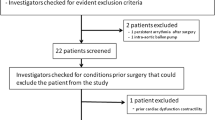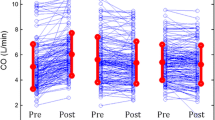Abstract
We assessed the effect of re-calibration time on cardiac output estimation and trending performance in a retrospective analysis of an intensive care unit patient population using error grid analyses. Paired thermodilution and arterial blood pressure waveform measurements (N = 2141) from 222 patient records were extracted from the Multiparameter Intelligent Monitoring in Intensive Care II database. Pulse contour analysis was performed by implementing a previously reported algorithm at calibration times of 1, 2, 8 and 24 h. Cardiac output estimation agreement was assessed using Bland–Altman and error grid analyses. Trending was assessed by concordance and a 4-Quadrant error grid analysis. Error between pulse contour and thermodilution increased with longer calibration times. Limits of agreement were −1.85 to 1.66 L/min for 1 h maximum calibration time compared to −2.70 to 2.41 L/min for 24 h. Error grid analysis resulted in 74.2 % of points bounded by 20 % error limits of thermodilution measurements for 1 h calibration time compared to 65 % for 24 h. 4-Quadrant error grid analysis showed <75 % of changes in pulse contour estimates to be within ±80 % of the change in the thermodilution measurement at any calibration time. Shorter calibration times improved the agreement of cardiac output pulse contour estimates with thermodilution. Use of minimally invasive pulse contour methods in intensive care monitoring could benefit from prospective studies evaluating calibration protocols. The applied pulse contour analysis method and thermodilution showed poor agreement to monitor changes in cardiac output.








Similar content being viewed by others
References
Alhashemi JA, Cecconi M, Hofer CK. Cardiac output monitoring: an integrative perspective. Crit Care. 2011;15(2):214. doi:10.1186/cc9996.
Marik PE. Noninvasive cardiac output monitors: a state-of the-art review. J Cardiothorac Vasc Anesth. 2013;27(1):121–34. doi:10.1053/j.jvca.2012.03.022.
Wesseling K, De Wit B, Weber J, Smith NT. A simple device for the continuous measurement of cardiac output. Adv Cardiovasc Phys. 1983;5(2):16–52.
Wesseling KH, Jansen JR, Settels JJ, Schreuder JJ. Computation of aortic flow from pressure in humans using a nonlinear, three-element model. J Appl Physiol. 1993;74(5):2566–73.
Truijen J, van Lieshout JJ, Wesselink WA, Westerhof BE. Noninvasive continuous hemodynamic monitoring. J Clin Monit Comput. 2012;26(4):267–78. doi:10.1007/s10877-012-9375-8.
Bogert LW, Wesseling KH, Schraa O, Van Lieshout EJ, de Mol BA, van Goudoever J, Westerhof BE, van Lieshout JJ. Pulse contour cardiac output derived from non-invasive arterial pressure in cardiovascular disease. Anaesthesia. 2010;65(11):1119–25. doi:10.1111/j.1365-2044.2010.06511.x.
de Wilde RB, Schreuder JJ, van den Berg PC, Jansen JR. An evaluation of cardiac output by five arterial pulse contour techniques during cardiac surgery. Anaesthesia. 2007;62(8):760–8. doi:10.1111/j.1365-2044.2007.05135.x.
Ameloot K, Van De Vijver K, Broch O, Van Regenmortel N, De Laet I, Schoonheydt K, Dits H, Bein B, Malbrain ML. Nexfin noninvasive continuous hemodynamic monitoring: validation against continuous pulse contour and intermittent transpulmonary thermodilution derived cardiac output in critically ill patients. Sci World J. 2013;2013:519080. doi:10.1155/2013/519080.
Godje O, Hoke K, Goetz AE, Felbinger TW, Reuter DA, Reichart B, Friedl R, Hannekum A, Pfeiffer UJ. Reliability of a new algorithm for continuous cardiac output determination by pulse-contour analysis during hemodynamic instability. Crit Care Med. 2002;30(1):52–8.
Hamilton TT, Huber LM, Jessen ME. PulseCO: a less-invasive method to monitor cardiac output from arterial pressure after cardiac surgery. Ann Thorac Surg. 2002;74(4):S1408–12.
Jellema WT, Wesseling KH, Groeneveld AB, Stoutenbeek CP, Thijs LG, van Lieshout JJ. Continuous cardiac output in septic shock by simulating a model of the aortic input impedance: a comparison with bolus injection thermodilution. Anesthesiology. 1999;90(5):1317–28.
Desebbe O, Henaine R, Keller G, Koffel C, Garcia H, Rosamel P, Obadia J-F, Bastien O, Lehot J-J, Haftek M, Critchley LAH. Ability of the third-generation FloTrac/Vigileo software to track changes in cardiac output in cardiac surgery patients: a polar plot approach. J Cardiothorac Vasc Anesth. 2013;27(6):1122–7. doi:10.1053/j.jvca.2013.03.008.
Fischer MO, Coucoravas J, Truong J, Zhu L, Gerard JL, Hanouz JL, Fellahi JL. Assessment of changes in cardiac index and fluid responsiveness: a comparison of Nexfin and transpulmonary thermodilution. Acta Anaesthesiol Scand. 2013;57(6):704–12. doi:10.1111/aas.12108.
Monnet X, Picard F, Lidzborski E, Mesnil M, Duranteau J, Richard C, Teboul JL. The estimation of cardiac output by the Nexfin device is of poor reliability for tracking the effects of a fluid challenge. Crit Care. 2012;16(5):R212. doi:10.1186/cc11846.
Stover JF, Stocker R, Lenherr R, Neff TA, Cottini SR, Zoller B, Bechir M. Noninvasive cardiac output and blood pressure monitoring cannot replace an invasive monitoring system in critically ill patients. BMC Anesthesiol. 2009;9:6. doi:10.1186/1471-2253-9-6.
Taton O, Fagnoul D, De Backer D, Vincent JL. Evaluation of cardiac output in intensive care using a non-invasive arterial pulse contour technique (Nexfin®) compared with echocardiography. Anaesthesia. 2013;68(9):917–23. doi:10.1111/anae.12341.
Peyton PJ, Chong SW. Minimally invasive measurement of cardiac output during surgery and critical care: a meta-analysis of accuracy and precision. Anesthesiology. 2010;113(5):1220–35. doi:10.1097/ALN.0b013e3181ee3130.
Trinkmann F, Sampels M, Doesch C, Papavassiliu T, Brade J, Schmid-Bindert G, Hoffmann U, Borggrefe M, Kaden JJ, Saur J. Is arterial pulse contour analysis using Nexfin a new option in the noninvasive measurement of cardiac output?—a pilot study. J Cardiothorac Vasc Anesth. 2013;27(2):283–7. doi:10.1053/j.jvca.2012.08.011.
Biais M, Nouette-Gaulain K, Cottenceau V, Vallet A, Cochard JF, Revel P, Sztark F. Cardiac output measurement in patients undergoing liver transplantation: pulmonary artery catheter versus uncalibrated arterial pressure waveform analysis. Anesth Analg. 2008;106(5):1480–6. doi:10.1213/ane.0b013e318168b309.
Biancofiore G, Critchley LAH, Lee A, Bindi L, Bisà M, Esposito M, Meacci L, Mozzo R, DeSimone P, Urbani L, Filipponi F. Evaluation of an uncalibrated arterial pulse contour cardiac output monitoring system in cirrhotic patients undergoing liver surgery. Br J Anaesth. 2009;102(1):47–54. doi:10.1093/bja/aen343.
Meng L, Phuong Tran N, Alexander BS, Laning K, Chen G, Kain ZN, Cannesson M. The impact of phenylephrine, ephedrine, and increased preload on third-generation Vigileo-FloTrac and esophageal doppler cardiac output measurements. Anesth Analg. 2011;113(4):751–7. doi:10.1213/ANE.0b013e31822649fb.
Hamzaoui O, Monnet X, Richard C, Osman D, Chemla D, Teboul JL. Effects of changes in vascular tone on the agreement between pulse contour and transpulmonary thermodilution cardiac output measurements within an up to 6-hour calibration-free period. Crit Care Med. 2008;36(2):434–40. doi:10.1097/01.ccm.ob013e318161fec4.
Gruenewald M, Meybohm P, Renner J, Broch O, Caliebe A, Weiler N, Steinfath M, Scholz J, Bein B. Effect of norepinephrine dosage and calibration frequency on accuracy of pulse contour-derived cardiac output. Crit Care. 2011;15(1):R22. doi:10.1186/cc9967.
Schloglhofer T, Gilly H, Schima H. Semi-invasive measurement of cardiac output based on pulse contour: a review and analysis. Can J Anaesth. 2014;. doi:10.1007/s12630-014-0135-8.
Sun JX, Reisner AT, Saeed M, Heldt T, Mark RG. The cardiac output from blood pressure algorithms trial. Crit Care Med. 2009;37(1):72–80. doi:10.1097/CCM.0b013e3181930174.
Zhang G, Mukkamala R. Continuous and minimally invasive cardiac output monitoring by long time interval analysis of a radial arterial pressure waveform: assessment using a large, public intensive care unit patient database. Br J Anaesth. 2012;109(3):339–44. doi:10.1093/bja/aes099.
Saeed M, Villarroel M, Reisner AT, Clifford G, Lehman LW, Moody G, Heldt T, Kyaw TH, Moody B, Mark RG. Multiparameter Intelligent Monitoring in Intensive Care II: a public-access intensive care unit database. Crit Care Med. 2011;39(5):952–60. doi:10.1097/CCM.0b013e31820a92c6.
Goldberger AL, Amaral LA, Glass L, Hausdorff JM, Ivanov PC, Mark RG, Mietus JE, Moody GB, Peng CK, Stanley HE. PhysioBank, PhysioToolkit, and PhysioNet: components of a new research resource for complex physiologic signals. Circulation. 2000;101(23):E215–20.
Elghazzawi ZF, Welch JP, Ladin Z, Ford-Carleton P, Cooper JB. Algorithm to identify components of arterial blood pressure signals during use of an intra-aortic balloon pump. J Clin Monit. 1993;9(4):297–308.
Zong W, Heldt T, Moody GB, Mark RG. An open-source algorithm to detect onset of arterial blood pressure pulses. In: Computers in cardiology. Cambridge: IEEE; 2003. p. 259–262.
Sun JX. Cardiac output estimation using arterial blood pressure waveforms. Cambridge: Massachusetts Institute of Technology; 2006.
Sun JX. Cardiac output estimation from arterial blood pressure waveforms. 2012. http://www.physionet.org/physiotools/cardiac-output/. Accessed 13 Nov 2013.
Bland JM, Altman DG. Statistical methods for assessing agreement between two methods of clinical measurement. Lancet. 1986;327(8476):307–10.
Critchley LA, Critchley JA. A meta-analysis of studies using bias and precision statistics to compare cardiac output measurement techniques. J Clin Monit Comput. 1999;15(2):85–91.
Agresti A, Coull BA. Approximate is better than “exact” for interval estimation of binomial proportions. Am Stat. 1998;52(2):119–26.
Rao J, Scott A. A simple method for the analysis of clustered binary data. Biometrics 1992;48(2):577–585.
Critchley LA. Bias and precision statistics: should we still adhere to the 30% benchmark for cardiac output monitor validation studies? Anesthesiology. 2011;114(5):1245. doi:10.1097/ALN.0b013e318215e1e5 (author reply 1245–1246).
Clarke WL, Cox D, Gonder-Frederick LA, Carter W, Pohl SL. Evaluating clinical accuracy of systems for self-monitoring of blood glucose. Diabetes Care. 1987;10(5):622–8.
Parkes JL, Slatin SL, Pardo S, Ginsberg BH. A new consensus error grid to evaluate the clinical significance of inaccuracies in the measurement of blood glucose. Diabetes Care. 2000;23(8):1143–8.
Nilsson LB, Nilsson JC, Skovgaard LT, Berthelsen PG. Thermodilution cardiac output–are three injections enough? Acta Anaesthesiol Scand. 2004;48(10):1322–7. doi:10.1111/j.1399-6576.2004.00514.x.
Critchley LA, Lee A, Ho AM-H. A critical review of the ability of continuous cardiac output monitors to measure trends in cardiac output. Anesth Analg. 2010;111(5):1180–92. doi:10.1213/ANE.0b013e3181f08a5b.
Buonaccorsi JP. Measurement error: models, methods, and applications. Boca Raton: CRC Press; 2010.
Carroll RJ, Ruppert D, Stefanski LA, Crainiceanu CM. Measurement error in nonlinear models: a modern perspective. Boca Raton: CRC Press; 2006.
Dunn G. Statistical evaluation of measurement errors: Design and analysis of reliability studies. New York: Wiley; 2009.
Fuller WA. Measurement Error Models. New York: Wiley; 2006.
Acknowledgments
This work was supported in part by the US Food and Drug Administration’s Medical Countermeasures Initiative. C.G.S., S.G., S.F., and D.G.S. are employed by the US Food and Drug Administration. C.G.S. was supported by an appointment to the Research Participation Program at the Center for Devices and Radiological Health administered by the Oak Ridge Institute for Science and Education through an interagency agreement between the US Department of Energy and the US Food and Drug Administration.
Author information
Authors and Affiliations
Corresponding author
Ethics declarations
Conflict of interest
The authors declare that they have no conflict of interest.
Additional information
Disclaimer The mention of commercial products, their sources, or their use in connection with material reported herein is not to be construed as either an actual or implied endorsement of such products by the Department of Health and Human Services.
Electronic supplementary material
Below is the link to the electronic supplementary material.
Rights and permissions
About this article
Cite this article
Scully, C.G., Gomatam, S., Forrest, S. et al. Importance of re-calibration time on pulse contour analysis agreement with thermodilution measurements of cardiac output: a retrospective analysis of intensive care unit patients. J Clin Monit Comput 30, 577–586 (2016). https://doi.org/10.1007/s10877-015-9749-9
Received:
Accepted:
Published:
Issue Date:
DOI: https://doi.org/10.1007/s10877-015-9749-9




